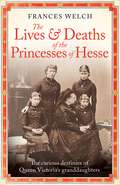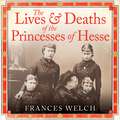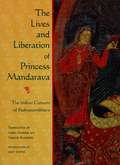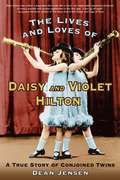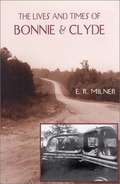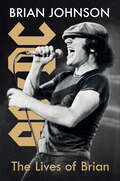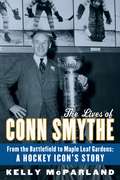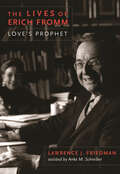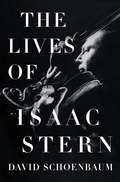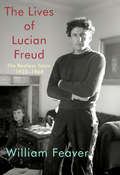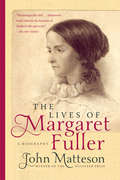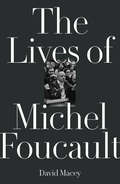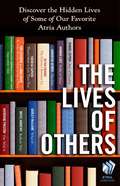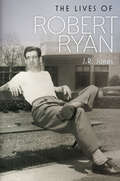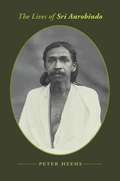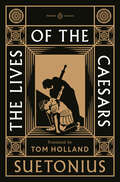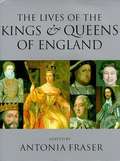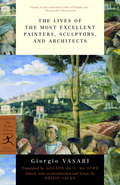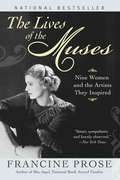- Table View
- List View
The Lives They Left Behind: Suitcases from a State Hospital Attic
by Darby Penney Peter StastnyThis book grew out of ten years of research conducted by two journalists who discovered a trove of abandoned trunks and suitcases in an attic at Willard State Hospital in New York. Through extensive research they were able to reconstruct the histories of ten patients who were hospitalized at Willard during the years before deinstitutionalization. Through the microcosm of individual lives the authors humanize the tragedy of our treatment of people deemed to be mentally ill.
The Lives and Deaths of the Princesses of Hesse: The curious destinies of Queen Victoria's granddaughters
by Frances WelchA gripping family saga and a portrait of a world in turmoilThe Princesses of Hesse were Queen Victoria's grandchildren. After the sudden death of her daughter Alice, Queen Victoria took an obsessive interest in the marriage prospects of the four girls she left behind. Very little went according to plan. Fortunately, Queen Victoria did not live to see her direst fears for the girls spouses being realised. She died in January 1901, just before her beloved Hesse granddaughters became caught up in the maelstrom of early 20th century Europe. The youngest sister, Alix, married Tsar Nicholas II of Russia; she was assassinated, along with the rest of her family, in a cellar in Ekaterinburg. The second, Ella, married the Russian Grand Duke Serge. After he was assassinated, she became a nun, only to be assassinated by the Bolsheviks twenty-four hours after Alix in 1918. The third, Irene, married the Kaiser's brother, Prince Henry, and was entangled in the 1918 German uprisings. The eldest sister, Princess Victoria, married Prince Louis Battenberg, and became the mother of Lord Louis Mountbatten and grandmother of Prince Philip, Duke of Edinburgh.Their lives were all dramatic, and this group biography shows how they interacted as sisters, forever jostling for status and relaying the politics and intrigues that surrounded them. Drawing on hundreds of previously unseen letters from the sisters as well as from their grandmother Queen Victoria, The Princesses of Hesse takes us on a sweeping journey across the tumultuous landscape of the turn of the century - from the dramas of the Russian Court to the Russian Revolution, and through both World Wars in which they often found themselves on opposing sides.Both intimate and epic in scope, Frances Welch's biography sheds new light on the four sisters' lives, illuminating a remarkable period of history in the process.
The Lives and Deaths of the Princesses of Hesse: The curious destinies of Queen Victoria's granddaughters
by Frances WelchA gripping family saga and a portrait of a world in turmoilThe Princesses of Hesse were Queen Victoria's grandchildren. After the sudden death of her daughter Alice, Queen Victoria took an obsessive interest in the marriage prospects of the four girls she left behind. Very little went according to plan. Fortunately, Queen Victoria did not live to see her direst fears for the girls spouses being realised. She died in January 1901, just before her beloved Hesse granddaughters became caught up in the maelstrom of early 20th century Europe. The youngest sister, Alix, married Tsar Nicholas II of Russia; she was assassinated, along with the rest of her family, in a cellar in Ekaterinburg. The second, Ella, married the Russian Grand Duke Serge. After he was assassinated, she became a nun, only to be assassinated by the Bolsheviks twenty-four hours after Alix in 1918. The third, Irene, married the Kaiser's brother, Prince Henry, and was entangled in the 1918 German uprisings. The eldest sister, Princess Victoria, married Prince Louis Battenberg, and became the mother of Lord Louis Mountbatten and grandmother of Prince Philip, Duke of Edinburgh.Their lives were all dramatic, and this group biography shows how they interacted as sisters, forever jostling for status and relaying the politics and intrigues that surrounded them. Drawing on hundreds of previously unseen letters from the sisters as well as from their grandmother Queen Victoria, The Princesses of Hesse takes us on a sweeping journey across the tumultuous landscape of the turn of the century - from the dramas of the Russian Court to the Russian Revolution, and through both World Wars in which they often found themselves on opposing sides.Both intimate and epic in scope, Frances Welch's biography sheds new light on the four sisters' lives, illuminating a remarkable period of history in the process.
The Lives and Deaths of the Princesses of Hesse: The curious destinies of Queen Victoria's granddaughters
by Frances WelchA gripping family saga and a portrait of a world in turmoilThe Princesses of Hesse were Queen Victoria's grandchildren. After the sudden death of her daughter Alice, Queen Victoria took an obsessive interest in the marriage prospects of the four girls she left behind. Very little went according to plan. Fortunately, Queen Victoria did not live to see her direst fears for the girls spouses being realised. She died in January 1901, just before her beloved Hesse granddaughters became caught up in the maelstrom of early 20th century Europe. The youngest sister, Alix, married Tsar Nicholas II of Russia; she was assassinated, along with the rest of her family, in a cellar in Ekaterinburg. The second, Ella, married the Russian Grand Duke Serge. After he was assassinated, she became a nun, only to be assassinated by the Bolsheviks twenty-four hours after Alix in 1918. The third, Irene, married the Kaiser's brother, Prince Henry, and was entangled in the 1918 German uprisings. The eldest sister, Princess Victoria, married Prince Louis Battenberg, and became the mother of Lord Louis Mountbatten and grandmother of Prince Philip, Duke of Edinburgh.Their lives were all dramatic, and this group biography shows how they interacted as sisters, forever jostling for status and relaying the politics and intrigues that surrounded them. Drawing on hundreds of previously unseen letters from the sisters as well as from their grandmother Queen Victoria, The Princesses of Hesse takes us on a sweeping journey across the tumultuous landscape of the turn of the century - from the dramas of the Russian Court to the Russian Revolution, and through both World Wars in which they often found themselves on opposing sides.Both intimate and epic in scope, Frances Welch's biography sheds new light on the four sisters' lives, illuminating a remarkable period of history in the process.
The Lives and Liberation of Princess Mandarava
by Sangye Khandro Janet Gyatso Lama ChonamThis lucid translation of a rare Tibetan text makes available for the first time to Western readers the remarkable life story of Princess Madarava. As the principal consort of the eighth century Indian master Padmasambhava before he introduced tantric Buddhism to Tibet, Mandarava is the Indian counterpart of the Tibetan consort Yeshe Tsogyal. Lives and Liberation recounts her struggles and triumphs as a Buddhist adept throughout her many lives and is an authentic deliverance story of a female Buddhist master. Those who read this book will gain inspiration and encouragement on the path to liberation.
The Lives and Loves of Daisy and Violet Hilton: A True Story of Conjoined Twins
by Dean JensenTHE LIVES AND LOVES OF DAISY AND VIOLET HILTON follows the poignant life story of twin sisters who were literally joined at the hip, set against the tumultuous backdrop of America during the first half of the 20th century. Daisy and Violet and an unforgettable cast of show-business characters come alive on the pages of this carefully researched and sensitively written biography.Reviews"Jensen'¬?s book is a testament to the fickleness of the entertainment world."-Tampa Bay Tribune"It is an affecting story, gently and honestly told without frills, without sensation. In Jensen'¬?s hands, the twins are always human, individuals, never freaks joined at the hips as the world saw them after their birth in 1908. . . Here, their story is pure."-Milwaukee Journal SentinelFrom the Trade Paperback edition.
The Lives and Times of Bonnie and Clyde
by E. R. MilnerFrom the Book Jacket: Relying on primary sources-oral history interviews, personal memoirs, newspaper articles, official records, diaries, and letters-E. R. Milner cuts through myth and legend to create this startling portrait of the real Bonnie and Clyde. In his prologue, Milner introduces Bonnie Parker and Clyde Barrow, showing them as they drive along a rural Louisiana lane toward the ambush that would put a dramatic end to their turbulent lives of crime. Milner then traces their backgrounds, noting the events that bring the two outlaws together. The ensuing adventures of Bonnie and Clyde featured gun battles, narrow escapes and captures, frequent moves, and, of necessity, several shifts in personnel over a short period of time. It was a life of wild action, betrayal, and sometimes even gallantry. In the abstract, an aura of romance surrounded this violent pair. Although the mythology surrounding Bonnie and Clyde is charged with drama and fascination, Milner reveals the truth behind the bloody legend, carefully gleaning materials from obscure locally published accounts, previously untapped court records, and archived but unpublished oral history accounts from some sixty victims, neighbors, relatives, and police who were involved in the exploits of the infamous duo. And the truth proves to be sufficiently exciting. Romance aside, the Barrow gang carved a grisly swath through Texas, Arkansas, Oklahoma, and Missouri. The string of deaths was long-and real: Akota, Oklahoma, sheriff severely wounded, deputy killed; Sherman, Texas, grocery clerk killed; Temple, Texas, man killed as gang attempts to steal his car; Joplin, Missouri, two officers killed; Alma, Arkansas, police officer killed; Crockette, Texas, prison guard killed; Miami, Oklahoma, police officer killed. Milner traces this violent path until 23 May 1934, when Bonnie and Clyde die in an ambush. Even dead, they draw crowds and are buried in a circus-like atmosphere. In death they continue to intrigue us in ways few criminals had before or have since. E. R. Milner is a professor of history and government at Tarrant College.
The Lives of Brian: A Memoir
by Brian JohnsonBrian Johnson’s memoir from growing up in a small town to starting his own band to ultimately replacing Bon Scott, the lead singer of one of the world biggest rock acts, AC/DC. They would record their first album together, the iconic Back in Black, which would become the biggest selling rock album of all time.Brian Johnson was born to a steelworker and WWII veteran father and an Italian mother, growing up in New Castle Upon Tyne, England, a working-class town. He was musically inclined and sang with the church choir. By the early ’70s he performed with the glam rock band Geordie, and they had a couple hits, but it was tough going. So tough that by 1976, they disbanded and Brian turned to a blue-collar life.Then 1980 changed everything. Bon Scott, the lead singer and lyricist of the Australian rock band AC/DC died at 33. The band auditioned singers, among them Johnson, whom Scott himself had seen perform and raved about. Within days, Johnson was in a studio with the band, working with founding members Angus and Malcolm Young, Cliff Williams, and Phil Rudd, along with producer Mutt Lange.When the album, Back in Black, was released in July—a mere three months after Johnson had joined the band—it exploded, going on to sell 50 million copies worldwide, and triggering a years-long worldwide tour. It has been declared “the biggest selling hard rock album ever made” and “the best-selling heavy-metal album in history.” The band toured the world for a full year to support the album, changing the face of rock music—and Brian Johnson’s life—forever.
The Lives of Conn Smythe: From the Battlefield to Maple Leaf Gardens: A Hockey Icon's Story
by Kelly McparlandThe first full-length biography of one of hockey's - and Canada's - most influential forces, Conn Smythe.While the story of the Toronto Maple Leafs has been told many times, there has never been a full biography of the man who created, built and managed the team, turning it from a small-market collection of second-rate players into the hockey and financial powerhouse that dominated Canadian sports and created a collection of Canadian icons along the way. From the 1920s to the mid-1960s, Conn Smythe was one of the best-known, highest-profile figures in the country - irascible, tempestuous, outspoken and controversial. He not only constructed a hockey team that dominated the league for long stretches, but was critical to the growth and shaping of the NHL itself. By building Maple Leaf Gardens and hiring Foster Hewitt to fill Canada's living rooms with weekly broadcasts, he turned Saturday night into hockey night, creating institutions and habits that became central to Canada's character and remain with us today.Smythe's story is much deeper and richer than the tale of a cantankerous hockey owner. Smythe fought in both world wars, fighting at Ypres and Passchendaele in the first war and landing at Normandy in the second. He was wounded in both and spent two years as a POW in a German camp after being shot down in 1917. He grew up in poverty and vowed to escape the life that was so incredibly hard on his family. Smythe was active in politics and ignited a national crisis over conscription that split the Liberal government in two and brought Mackenzie King to the brink of resignation.This book tells the life of one of the country's great characters, a man who helped shape and define us and who left behind national habits and institutions that continue to lay at the heart of what makes Canada, Canada.From the Hardcover edition.
The Lives of Erich Fromm: Love's Prophet
by Lawrence J. Friedman Anke M. SchreiberThis &“brilliantly comprehensive study&” explores the influential thinker&’s contributions to psychology, philosophy and more—&“academic biography at its best&” (Kirkus, starred review). Erich Fromm was a political activist, psychologist, psychoanalyst, philosopher, and one of the most important intellectuals of the twentieth century. Known for his theories of personality and political insight, Fromm dissected the sadomasochistic appeal of populist dictators. He eloquently championing the virtues of love rooted in joyful contact with others and humanity at large. Admired all over the world, Fromm continues to inspire with his message of universal brotherhood. In the first systematic study of Fromm's influences and achievements, Lawrence J. Friedman revisits the thinker's most important works, including Escape from Freedom and The Art of Loving. He also recounts Fromm's political activism as a founder of Amnesty International, the National Committee for a Sane Nuclear Policy, and other peace groups. Friedman also reveals Fromm's support for anti-Stalinist democratic movements in Central and Eastern Europe and his efforts to revitalize American democracy. Friedman elucidates Fromm's key intellectual contributions, especially his innovative concept of "social character," in which social institutions and practices shape the inner psyche, and he clarifies Fromm's conception of love as an acquired skill. Taking full stock of the thinker's historical and global accomplishments, Friedman portrays a man of immense authenticity and spirituality who made life in the twentieth century more humane than it might have been.
The Lives of Erich Fromm: Love's Prophet
by Lawrence FriedmanErich Fromm was a political activist, psychologist, psychoanalyst, philosopher, and one of the most important intellectuals of the twentieth century. Known for his theories of personality and political insight, Fromm dissected the sadomasochistic appeal of brutal dictators while also eloquently championing love—which, he insisted, was nothing if it did not involve joyful contact with others and humanity at large. Admired all over the world, Fromm continues to inspire with his message of universal brotherhood and quest for lasting peace.The first systematic study of Fromm's influences and achievements, this biography revisits the thinker's most important works, especially Escape from Freedom and The Art of Loving, which conveyed important and complex ideas to millions of readers. The volume recounts Fromm's political activism as a founder and major funder of Amnesty International, the National Committee for a Sane Nuclear Policy, and other peace groups. Consulting rare archival materials across the globe, Lawrence J. Friedman reveals Fromm's support for anti-Stalinist democratic movements in Central and Eastern Europe and his efforts to revitalize American democracy. For the first time, readers learn about Fromm's direct contact with high officials in the American government on matters of war and peace while accessing a deeper understanding of his conceptual differences with Freud, his rapport with Neo-Freudians like Karen Horney and Harry Stack Sullivan, and his association with innovative artists, public intellectuals, and world leaders. Friedman elucidates Fromm's key intellectual contributions, especially his innovative concept of "social character," in which social institutions and practices shape the inner psyche, and he clarifies Fromm's conception of love as an acquired skill. Taking full stock of the thinker's historical and global accomplishments, Friedman portrays a man of immense authenticity and spirituality who made life in the twentieth century more humane than it might have been.
The Lives of Frederick Douglass
by Robert S. LevineFrederick Douglass's changeable sense of his own life story is reflected in his many conflicting accounts of events during his journey from slavery to freedom. Robert S. Levine creates a fascinating collage of this elusive subject--revisionist biography at its best, offering new perspectives on Douglass the social reformer, orator, and writer.
The Lives of Isaac Stern
by David SchoenbaumA centennial celebration of the career and legacy of the first made-in-America violin virtuoso and one of the twentieth century’s greatest musicians. No single American could personify what Henry Luce called the American Century. But over his eighty-one years, Isaac Stern came closer than most. Russian-Jewish parents brought him to San Francisco at ten months; practice and talent got him to Carnegie Hall, critical acclaim, and the attention of the legendary impresario Sol Hurok at twenty-five. As America came of age, so too did Stern. He would go on to make music on five continents, records in formats from 78 rpm to digital, and friends as different as Frank Sinatra and Sir Isaiah Berlin. An unofficial cultural ambassador for Cold War America, he toured the world from Tokyo to Tehran and Tbilisi. He also shaped public policy from New York and Washington to Jerusalem and Shanghai. His passion for developing young talents—including Itzhak Perlman, Pinchas Zukerman, Yo-Yo Ma, and Midori—led him to loan instruments to needy players, broker gigs for Soviet émigrés, and reply in person to inquiring fifth-graders. As the first historian to mine his papers at the Library of Congress, David Schoenbaum traces Stern’s sixty-year career from his formative years in San Francisco to concurrent careers as an activist, public citizen, chairman, and cultural leader in the Jewish community. Wide-ranging yet intimate, The Lives of Isaac Stern is a portrait of an artist and statesman who began as an American dreamer and left a lasting inheritance to his art, profession, and the world.
The Lives of Lucian Freud: 1968-2011 (Biography And Autobiography Ser.)
by William FeaverThe first biography of the epic life of one of the most important, enigmatic and private artists of the 20th century. Drawn from almost 40 years of conversations with the artist, letters and papers, it is a major work written by a well-known British art critic. Lucian Freud (1922-2011) is one of the most influential figurative painters of the 20th century. His paintings are in every major museum and many private collections here and abroad. William Feaver's daily calls from 1973 until Freud died in 2011, as well as interviews with family and friends were crucial sources for this book. Freud had ferocious energy, worked day and night but his circle was broad including not just other well-known artists but writers, bluebloods, royals in England and Europe, drag queens, fashion models gamblers, bookies and gangsters like the Kray twins. Fierce, rebellious, charismatic, extremely guarded about his life, he was witty, mischievous and a womanizer. This brilliantly researched book begins with the Freuds' life in Berlin, the rise of Hitler and the family's escape to London in 1933 when Lucian was 10. Sigmund Freud was his grandfather and Ernst, his father was an architect. In London in his twenties, his first solo show was in 1944 at the Lefevre Gallery. Around this time, Stephen Spender introduced him to Virginia Woolf; at night he was taking Pauline Tennant to the Gargoyle Club, owned by her father and frequented by Dylan Thomas; he was also meeting Sonia Orwell, Cecil Beaton, Auden, Patrick Leigh-Fermor and the Aly Khan, and his muse was a married femme fatale, 13 years older, Lorna Wishart. But it was Francis Bacon who would become his most important influence and the painters Frank Auerbach and David Hockney, close friends. This is an extremely intimate, lively and rich portrait of the artist, full of gossip and stories recounted by Freud to Feaver about people, encounters, and work. Freud's art was his life—"my work is purely autobiographical"—and he usually painted only family, friends, lovers, children, though there were exceptions like the famous small portrait of the Queen. With his later portraits, the subjects were often nude, names were never given and sittings could take up to 16 months, each session lasting five hours but subjects were rarely bored as Freud was a great raconteur and mimic. This book is a major achievement, a tour de force that reveals the details of the life and innermost thoughts of the greatest portrait painter of our time. Volume I has 41 black and white integrated images, and 2 eight-page color inserts.
The Lives of Lucian Freud: The Restless Years, 1922-1968
by William FeaverThe first biography of the epic life of one of the most important, enigmatic and private artists of the 20th century. Drawn from almost 40 years of conversations with the artist, letters and papers, it is a major work written by a well-known British art critic. Lucian Freud (1922-2011) is one of the most influential figurative painters of the 20th century. His paintings are in every major museum and many private collections here and abroad. William Feaver's daily calls from 1973 until Freud died in 2011, as well as interviews with family and friends were crucial sources for this book.Freud had ferocious energy, worked day and night but his circle was broad including not just other well-known artists but writers, bluebloods, royals in England and Europe, drag queens, fashion models gamblers, bookies and gangsters like the Kray twins. Fierce, rebellious, charismatic, extremely guarded about his life, he was witty, mischievous and a womanizer. This brilliantly researched and well written book begins with the Freuds' life in Berlin, the rise of Hitler and the family's escape to London in 1933 when Lucian was 10. Sigmund Freud was his grandfather and Ernst, his father was an architect. In London in his twenties, his first solo show was in 1944 at the Lefevre Gallery. Around this time, Stephen Spender introduced him to Virginia Woolf, at night he was taking Pauline Tennant to the Gargoyle Club, owned by her father and frequented by Dylan Thomas; he was also meeting Sonia Orwell, Cecil Beaton, Auden, Patrick Leigh-Fermor and the Aly Khan, and his muse was a married femme fatale, 13 years older, Lorna Wishart. But it was Francis Bacon who would become his most important influence and the painters Frank Auerbach and David Hockney, close friends. On Freud's first trip to Paris in 1946 he met the artists Picasso, Giacometti, Andre Breton, Alexander Calder and Balthus. Next was a trip to Greece then trips to the south of France with the Graham Sutherlands. More shows followed in London and Paris and Kenneth Clark tried to buy a painting in 1947 for the Tate, Alfred Barr did buy one for MoMa in 1948, the year Freud married his first wife Kitty Garman Epstein, the daughter of the famous sculptor, Jacob Epstein. In 1952 he eloped with Lady Caroline Blackwood to Paris where they married in 1953; there were two girls from the first marriage but he had twelve other children from his many liasons. This is an extremely intimate, lively and rich portrait of the artist, full of gossip and stories recounted by Freud to Feaver about people, encounters, and work. Freud's art was his life—"my work is purely autobiographical"—and he usually painted only family, friends, lovers, children, though there were exceptions like the famous small portrait of the Queen. With his later portraits, the subjects were often nude, names were never given and sittings could take up to 16 months, each session lasting five hours but subjects were rarely bored as Freud was a great raconteur and mimic. This book is a major achievement, a tour de force that reveals the details of the life and innermost thoughts of the greatest portrait painter of our time. Volume I has 41 black and white integrated images, and 2 eight-page color inserts.
The Lives of Margaret Fuller: A Biography
by John Matteson"Psychologically rich. . . . Matteson's book restores the heroism of [Fuller's] life and work."--The New Yorker A brilliant writer and a fiery social critic, Margaret Fuller (1810-1850) was perhaps the most famous American woman of her generation. Outspoken and quick-witted, idealistic and adventurous, she became the leading female figure in the transcendentalist movement, wrote a celebrated column of literary and social commentary for Horace Greeley's newspaper, and served as the first foreign correspondent for an American newspaper. While living in Europe she fell in love with an Italian nobleman, with whom she became pregnant out of wedlock. In 1848 she joined the fight for Italian independence and, the following year, reported on the struggle while nursing the wounded within range of enemy cannons. Amid all these strivings and achievements, she authored the first great work of American feminism: Woman in the Nineteenth Century. Despite her brilliance, however, Fuller suffered from self-doubt and was plagued by ill health. John Matteson captures Fuller's longing to become ever better, reflected by the changing lives she led.
The Lives of Michel Foucault
by David MaceyThe classic biography of the radical French philosopher with a new afterword by acclaimed Foucault scholar Stuart Elden.When he died of an AIDS-related condition in 1984, Michel Foucault had become the most influential French philosopher since the end of World War II. His powerful studies of the creation of modern medicine, prisons, psychiatry, and other methods of classification have had a lasting impact on philosophers, historians, critics, and novelists the world over. But as public as he was in his militant campaigns on behalf of prisoners, dissidents, and homosexuals, he shrouded his personal life in mystery.In The Lives of Michel Foucault -- written with the full cooperation of Daniel Defert, Foucault's former lover -- David Macey gives the richest account to date of Foucault's life and work, informed as it is by the complex issues arising from his writings. In this new edition, Foucault scholar Stuart Elden has contributed a new afterword assessing the contribution of the biography in the light of more recent literature.
The Lives of Muhammad
by Kecia AliKecia Ali delves into the many ways the Prophet's life story has been told from the earliest days of Islam to the present, by both Muslims and non-Muslims. Emphasizing the major transformations since the nineteenth century, she shows that far from being mutually opposed, these various perspectives have become increasingly interdependent.
The Lives of Others
by Shirley Maclaine Reyna Grande Katherine Preston Jessica Buchanan Hannah Luce Bryce Andrews Samantha GeimerSocrates boldly proclaimed “the unexamined life is not worth living.” At Atria, we think that the examined life is worth sharing. With that in mind, we present The Lives of Others, a free collection of excerpts from some inspiring memoirs by Atria’s award-winning authors. Selections include: Badluck Way by Bryce Andrews Impossible Odds by Jessica Buchanan There’s More to Life Than This by Theresa Caputo Bird of Paradise by Raquel Cepeda The Girl by Samantha Geimer The Distance Between Us by Reyna Grande Fields of Grace by Hannah Luce What If . . . by Shirley MacLaine Out with It by Katherine Preston By Some Miracle I Made it Out of There by Tom Sizemore
The Lives of Robert Ryan (Wesleyan Film Ser.)
by J R JonesAn &“engrossing new biography&” of the actor famed for his menacing onscreen persona—and his offscreen work for peace and civil rights (Film Quarterly). The Lives of Robert Ryan is an in-depth look at the gifted, complex, intensely private man Martin Scorsese called &“one of the greatest actors in the history of American film.&” The son of a Chicago construction executive with strong ties to the Democratic machine, Ryan became a star after World War II on the strength of his menacing performance as an anti-Semitic murderer in the film noir Crossfire. Over the next quarter century, he created a gallery of brooding, neurotic, and violent characters in such movies as Bad Day at Black Rock, Billy Budd, The Dirty Dozen, and The Wild Bunch. His riveting performances expose the darkest impulses of the American psyche during the Cold War. At the same time, Ryan&’s marriage to a liberal Quaker and his own conscience launched him into a tireless career of peace and civil rights activism that stood in direct contrast to his screen persona. Drawing on unpublished writings and revealing interviews, film critic J.R. Jones deftly explores the many contradictory facets of Robert Ryan&’s public and private lives, and how these lives intertwined in one of the most compelling actors of a generation. &“Engaging . . . Jones describes a complex man who grappled publicly with the world&’s demons and privately with his own, among them alcohol and depression.&” —Associated Press &“Jones has done a superb job . . . A masterly biography.&” —Library Journal Includes photographs
The Lives of Sri Aurobindo
by Peter HeehsSince his death in 1950, Sri Aurobindo Ghose has been known primarily as a yogi and a philosopher of spiritual evolution who was nominated for the Nobel Prize in peace and literature. But the years Aurobindo spent in yogic retirement were preceded by nearly four decades of rich public and intellectual work. Biographers usually focus solely on Aurobindo's life as a politician or sage, but he was also a scholar, a revolutionary, a poet, a philosopher, a social and cultural theorist, and the inspiration for an experiment in communal living.Peter Heehs, one of the founders of the Sri Aurobindo Ashram Archives, is the first to relate all the aspects of Aurobindo's life in its entirety. Consulting rare primary sources, Heehs describes the leader's role in the freedom movement and in the framing of modern Indian spirituality. He examines the thinker's literary, cultural, and sociological writings and the Sanskrit, Bengali, English, and French literature that influenced them, and he finds the foundations of Aurobindo's yoga practice in his diaries and unpublished letters. Heehs's biography is a sensitive, honest portrait of a life that also provides surprising insights into twentieth-century Indian history.
The Lives of the Caesars (A Penguin Classics Hardcover)
by SuetoniusA masterful new translation of Suetonius' renowned biography of the twelve Caesars, bringing to life a portrait of the first Roman emperors in stunning detailA Penguin ClassicThe ancient Roman empire was the supreme arena, where emperors had no choice but to fight, to thrill, to dazzle. To rule as a Caesar was to stand as an actor upon the great stage of the world. No biographies invite us into the lives of the Caesars more vividly or intimately than those by Gaius Suetonius Tranquillus, written from the center of Rome and power, in the early 2nd century AD.By placing each Caesar in the context of the generations that had gone before, and connecting personality with policy, Suetonius succeeded in painting Rome&’s ultimate portraits of power. The shortfalls, foreign policy crises and sex scandals of the emperors are laid bare; we are shown their tastes, their foibles, their eccentricities; we sit at their tables and enter their bedrooms. The result is perhaps the most influential series of biographies ever written.That Rome lives more vividly in people's imagination than any other ancient empire owes an inordinate amount to Suetonius. Now award-winning author and translator Tom Holland brings us even closer in a new, spellbinding translation. Giving a deeper understanding of the personal lives of Rome&’s first emperors, and of how they swayed the fates of millions, The Lives of the Caesars is an astonishing, immersive experience of a time and culture at once familiar and utterly alien to our own.
The Lives of the Kings and Queens of England
by Antonia FraserUpdated with a new chapter on the Windsors, including the death of Diana, this reference offers a concise guide to the great dynasties of English royalty.
The Lives of the Most Excellent Painters, Sculptors, and Architects
by Giorgio Vasari Philip Jacks Gaston du de VereA painter and architect in his own right, Giorgio Vasari (1511-74) achieved immortality for this book on the lives of his fellow Renaissance artists, first published in Florence in 1550. Although he based his work on a long tradition of biographical writing, Vasari infused these literary portraits with a decidedly modern form of critical judgment. The result is a work that remains to this day the cornerstone of art historical scholarship. Spanning the period from the thirteenth century to Vasari's own time, the Lives opens a window on the greatest personalities of the period, including Giotto, Brunelleschi, Mantegna, Leonardo, Raphael, Michelangelo, and Titian. This Modern Library edition, abridged from the original text with notes drawn from earlier commentaries, as well as current research, reminds us why The Lives of the Most Excellent Painters, Sculptors, and Architects is indispensable to any student interested in Renaissance art.
The Lives of the Muses
by Francine ProseAll loved, and were loved by, their artists, and inspired them with an intensity of emotion akin to Eros.In a brilliant, wry, and provocative book, National Book Award finalist Francine Prose explores the complex relationship between the artist and his muse. In so doing, she illuminates with great sensitivity and intelligence the elusive emotional wellsprings of the creative process.

